”He on all occasions professes a detestation of what he calls ”can’t”; says it will banish from England all that is pure and good; and that while people are looking after the shadow, they lose the substance of the goodness; he says, that the best mode left for conquering it, is to expose it to ridicule, the only weapon, added he, that the English climate cannot rust” ( On Lord Byron ). In the field of cartoons and caricature it could be claimed, with some justification that the British—have often wielded the sharpest pencils of all.

Un jeu de cartes brocarde les Suisses Le Revers du jeu des Suysses. Lyon (?), 1514 ou 1515. Gravure sur bois, lettre typographiée. 36,2 x 26,2 cm BnF, Estampes EA 17 Rés. tome I Longtemps tenue pour la plus ancienne caricature, cette xylographie à thème très politique paraît se situer en 1514 ou 1515, dans le contexte de la bataille de Marignan. Nettement anti-suisse, la gravure est copiée sur un modèle germanique, peut-être suisse, raillant la politique européenne des grands et les arrangements passés entre eux.
Before the usage of the term “cartoon” in its modern sense in the mid nineteenth-century, satirical and humorous drawings of all kinds were referred to as caricatures. Its origins are a bit obscure, but may have existed in the time of Aristophanes bawdy plays. What may be seen as possibly the earliest known political cartoon is an anonymous woodcut entitled Le Revers du Jeu des Suysses ”The Other Side of the Swiss Game”, produced around 1514, though perhaps earlier. In this, the pope, the Holy Roman Emperor, and the kings of France and England can be seen playing cards while, under the table, a Swiss soldier stacks the decks in a satirical commentary on French ambitions in Italy; the support of elite Swiss soldiers was essential to France.
At about the same time, Pope Alexander VI was depicted as a devil and in another drawing a Jesuit priest is given a wolf’s head. Perhaps the most memorable caricature of this period—and one exactly datable and attributable to a known artist—was an anti-Protestant woodcut by Erhard Schoen of 1521, showing the Devil playing a pair of bagpipes, the bellows of which are depicted as the head of Martin Luther; the reformation sanctioned and unleash this form of satire as propaganda.
A number of other artists of this period also produced heavily allegorical and often fantastical drawings which have resonances in the modern cartoon. However, it was in Italy at the hands of the Carracci family and others such as Pier Leone Ghezzi, the first artist to be regarded as a professional, that the modern cartoon can be said to have been developed. It was also in Italy that these early caricaturas flourished, and almost uniquely so until collections of such drawings, such as Ghezzi’s, were discovered by the English during the ”Grand Tour” of Renaissance Italy beginning in the late seventeenth-century. Mary and Matthew Darly and later Hogarth, were influenced by this form of cultural aesthetic ;Hogarth began his sequence of “modern moral subjects” in England in the 1730s. Hogarth was also the first to mass produce his own work in the form of engravings.
He was followed by successors who differed from him in that they had their work reproduced by etching rather than engraving and they were more concerned with political propaganda and pictorial jokes than moral themes. The first of these political satirists was George Townshend, the hard-drinking aristocratic buddy of Horace Walpole. His bad-tempered, impulsive, arrogant, imprudent and outspoken nature, completely unsuited to political life, became an asset when channeled towards political satire. However, Hogarth’s two most important successors in the 18th century were Thomas Rowlandson and James Gillray.

Noddle-Island or How are we Decieved Hand-coloured etching published by Matthew Darly in 1776 depicting a lady on whose grotesquely extended coiffure military operations are proceeding. At the top of her pyramid of hair soldiers fire a cannon from a rectangular American fort at other soldiers firing a cannon from an adjacent mound composed of ringlets of hair. Two immense flags flying from the fort bear, one a crocodile, the other a cross-bow and arrows; the flags of their opponents, the English, are decorated one with an ass, the other with a fool's cap and bells. Below this combat are tents and two men with a cannon. On the lower right rolls of hair red-coats march in single file, followed by a baggage waggon. Lower down again, red-coats in boats are rowing towards two ships in full sail. This evidently satirizes the evacuation of Boston by Howe on 17 Mar. 1776. There were many protests against the misleading account given in the 'Gazette'. Walpole wrote "nobody was deceived". The 'How' in the title is a pun on the name of the commander-in-chief.
”…we find little to interest us in French pictorial satire until that monstrous growth of political caricature created by the Revolution. Italy in the same period has but little to offer us, Germany as little or less; and it is to England that we must turn for the pictorial humour, whether social or political, of that interesting epoch. And this because the England of that time is a self-conscious creature, emergent from a successful struggle for freedom, and strong enough to enjoy a hearty laugh—even at her own expense. While the Bastille still frowns over France, the Inquisition and the Jesuits are an incubus upon Spain and Italy, while Germany is split up into little principalities, Dukedoms, Bishoprics, Palatinates, England has already won for herself the great boon of freedom of thought, freedom of speech, freedom of religious and political
ion. The satirist could here find expression and appreciation.” ( Selwyn Brinton )Rowlandson was primarily a social satirist and made numerous prints that commented on the manners and fashions of the day, or that depicted pornographic and lude scenes. However, he is probably best known for his creation of what is perhaps the first cartoon character, Dr Syntax, in The Three Tours of Dr Syntax (1809, 1820, and 1821). Though Rowlandson did in fact produce many fine political drawings, especially of Napoleon, it was James Gillray, with the support of the leading West End print-seller Mrs Hannah Humphrey, who dominated the political field in this period. His attacks on Pitt, George III and George IV, the French Revolution, and Napoleon bore a savagery and passion that has never really returned to the genre, outside of the American underground counterculture.
It was the golden age of British satire. During the late 18th and early 19th centuries, illustrators like Rowlandson, Gillray, and George Cruikshank made British caricature a vital popular art form,a vulgar yet refined type of work that took the Ghezzi style and expanded and exalted its extremes. However, the first British origins of this satire seem to be in the Mary and Matthew Darly pictorial images of the late seventeenth-century, when the colonial wealth of the empire brought on the first wave of conspicuous consumption and an importation of styles from France, and more specifically, Italy.
Through their colorful renderings of humorously exaggerated people in absurd scenarios, these artists offered ridicule and criticism of prevailing political, social, and religious positions of the day to their educated, affluent audiences. It is generally acknowledged that the heyday, at least in its more visceral, biting and burlesque form, of English satirical art began with William Hogarth in the mid eighteenth century and ended in the mid 1830’s when Victoria took the throne and the somewhat stifling forms of morality that are now associated with her name terminated the raucous and barbed, and totally unchained humour of earlier generations.
In turn, the 1820’s decade witnessed the rise of the last two great satirical artists; George Cruikshank and William Heath.William Heath is a good example of this biting and bawdy British satire from the end of the period. William Heath’s etched art was at its sharpest when he delineated the life and habits of the middle and upper classes. Some of the most humorous images of morals, manners and dress in the history of art were etched by his hand.

- ”. Appearing as common market-women, Eldon and Wellington set up for battle, backed by John Bull and an Irish beggar, respectively. Exceedingly witty, this print hides numerous jabs and jokes, from Sir Robert Peel, who stands in the background wearing a marketwoman’s garb, to John Bull’s hand on Eldon’s ample marketwoman’s posterior.”
William Heath was one of the most underappreciated of the British caricaturists. According to the DNB, from 1825 to 1826, “Heath was in Scotland, writing and illustrating the first magazine in the world to be given over, predominantly, to caricatures: The Glasgow Looking Glass, later the Northern Looking Glass….” When Heath returned to London in 1827, he began signing his prints with a drawing of the actor Liston in the role of Paul Pry from John Poole’s 1825 comedy. However the signature,and his engaging designs attracted so many plagiarists that Heath was forced to abandon it in 1829.

- Mary Darly. “Among their productions were dozens of prints representing a group of men labeled by contemporaries as ‘macaronis,’ allegedly because of their affectation of foreign tastes and fashions. The macaronis were an ephemeral phenomenon, as well as an extension of the fops and beaus of the earlier part of the century. ”
Among the prints that attracted so much attention in the spring of 1829 were a series of satires on the question of Catholic emancipation featuring King George IV, Prime Minister Wellington, and Lords Eldon and Brougham.There was no question of being politically correct and Heath was unabashedly anti-Catholic and anti- Irish, whom he regarded as heathen, dirty,uncouth and criminal. Titles included The Slap-Up Swell Wot Drives When Ever He Likes, The Guard Wot Looks After the Sovereign, The Man Wot Drives the Opposition, The Cad Wots Been Appointed Rat-Catcher to the Sovereign, and The Man Wot’s Been Made Foreman to the British, among others.
This print, The Man Wots Got the Whip Hand of ‘Em All, depicts a Stanhope Press with the legs of King George. It wears a cap of Liberty inscribed Free Press and holds a giant pen with fire-spitting serpents. Prime Minister Wellington’s departing legs and hat are seen at the top right, while the legs and buckled shoes of Lord Eldon are seen at the left.
It was a new art form “a new species of painting, which may be termed the moral comic;” meaning, thereby, that the instinctive humour of the man’s art is generally (not, as we shall see, always) directed to some moral purpose, some lesson of conduct to be thence derived. That is just where Hogarth connects himself, inevitably and intimately, with the Puritan England which had preceded him. Not for nothing had that century, into whose last years he was born, seen the great uprising of Puritan England,—the struggle for civil and political liberty, and its achievement,—the Ironsides of Cromwell with Bible and uplifted sword. That intensity of moral and spiritual conviction, that earnestness about life and its issues was yet in the nation’s blood, and must find some outlet in the returning world of art, which its own austerity had banished; but, in another sense, mark how truly Hogarth connects himself with the later caricaturists of the coming age.”
The last of the really important British graphic satirists of the Georgian period was George Cruikshank. Moral repression was the norm after him, and soon France began to dominate the scene under the influence of Honore Daumier and Charles Philipon. Working at first with his brother Robert in the Scourge, Cruickshank’s illustrations to William Hone’s pamphlets attacking George IV forced the king to try to bribe him to tone down his work. He also produced a series called Monstrosities (1816-1829), mocking fashions, and was so popular that Sketches by Boz, which he illustrated, sold at first largely on the artist’s name rather than that of the then little-known writer Charles Dickens. However, in about 1847 he joined the Total Abstinence movement and his work lost its edge completely.

The Macaroni. A Real Character at the Late Masquerade Mezzotint by Philip Dawe; printed for John Bowles in 1773 "This gentleman shows off the fashion of the day, from the rosettes on his shoes to the tiny three-cornered hat at the top of his headdress, a structure made of enormous side curls, a gigantic club, and a pyramid of hair. While the Oxford English Dictionary cites Walpole’s comment in 1764 as the first recorded use of the term, the Macaronies came to greatest prominence in the early 1770s."


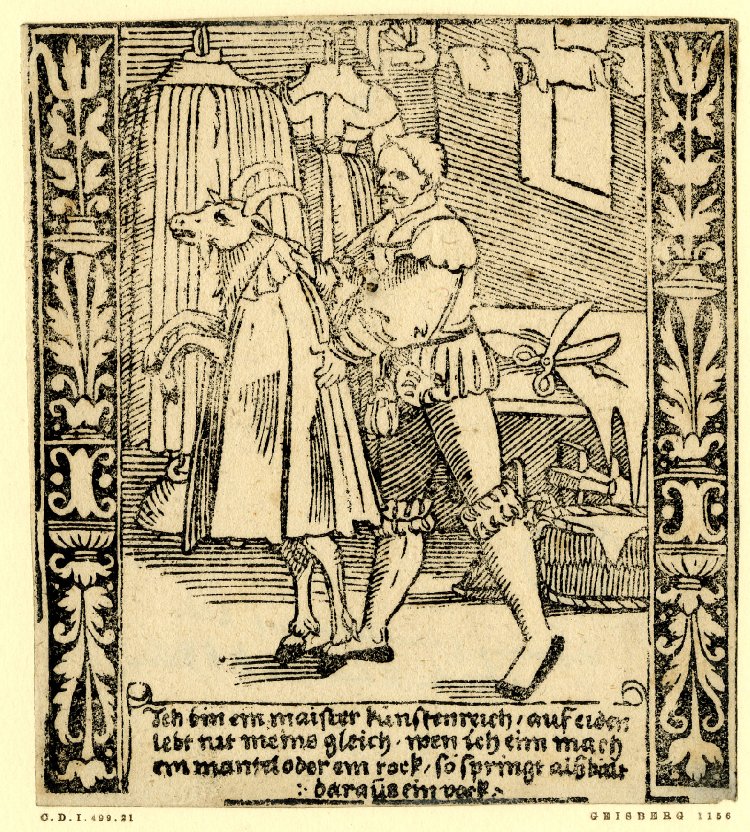
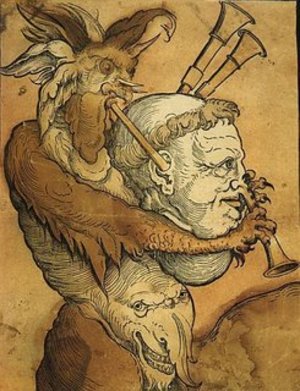
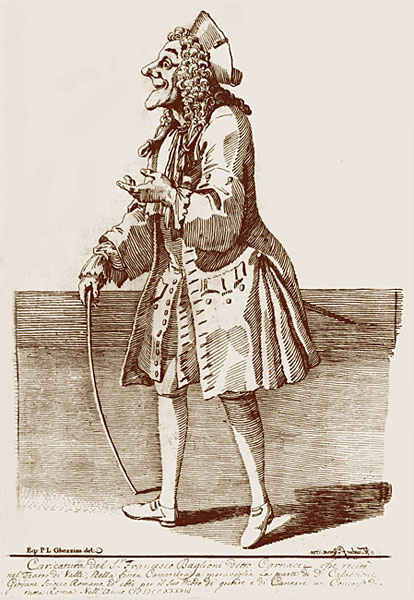

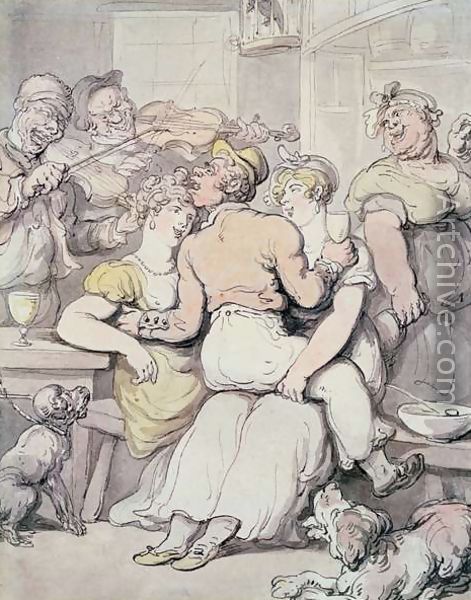
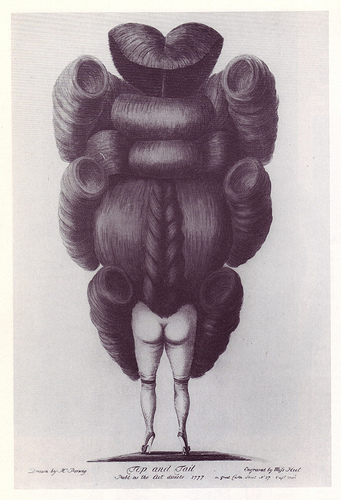







 COMMENTS
COMMENTS